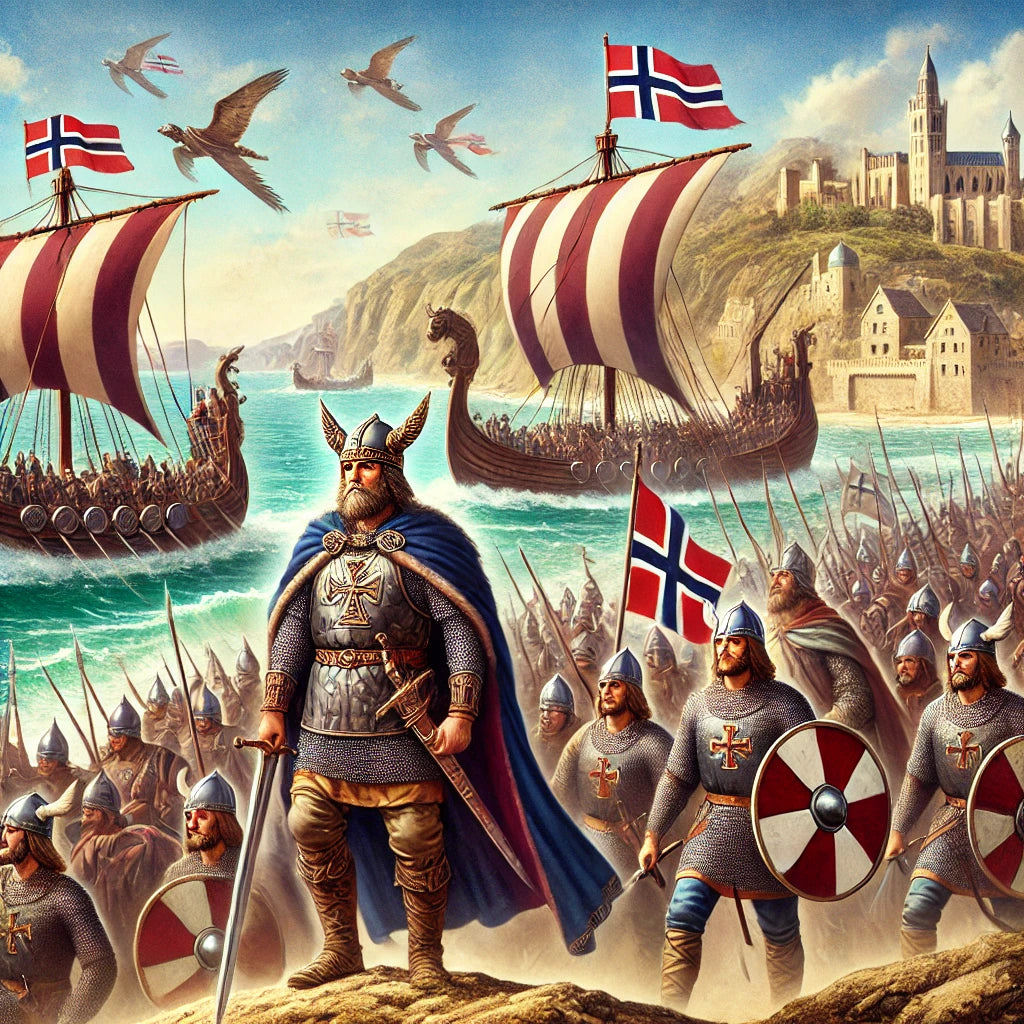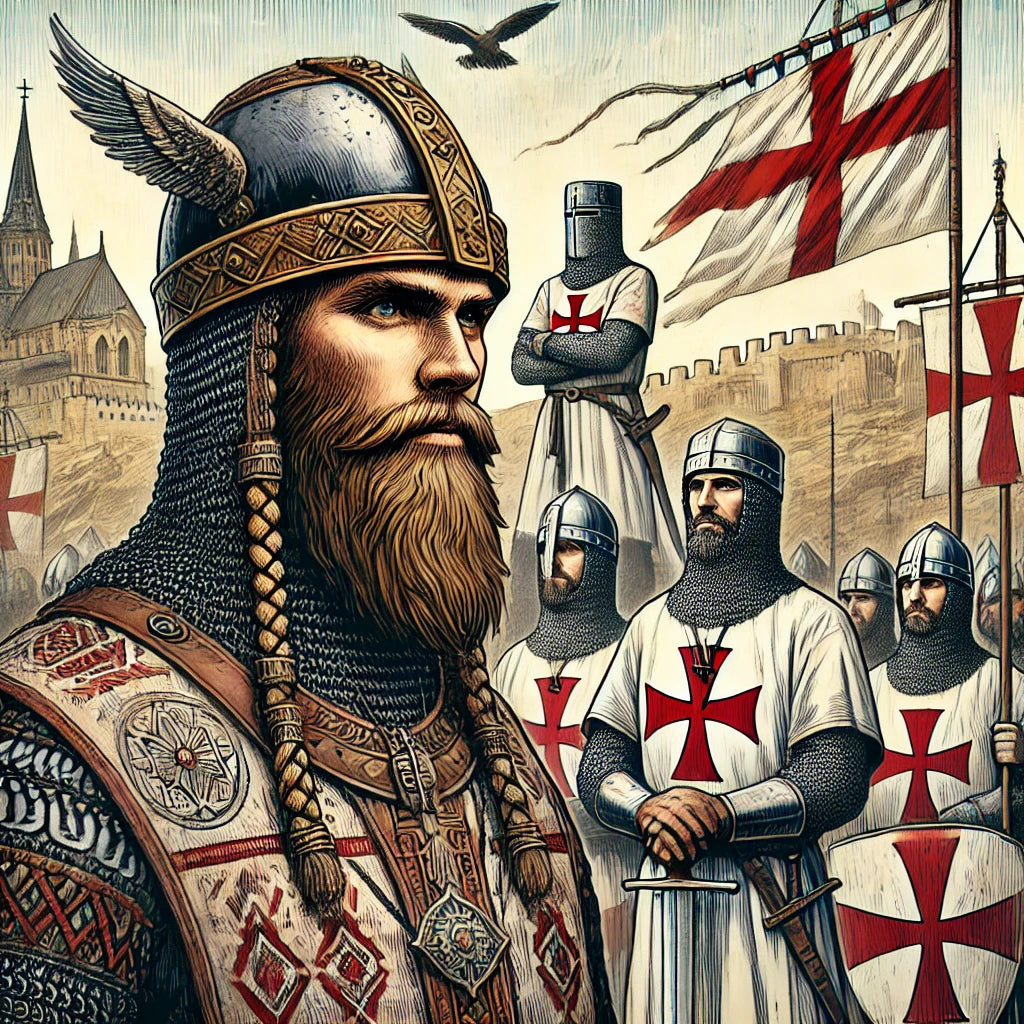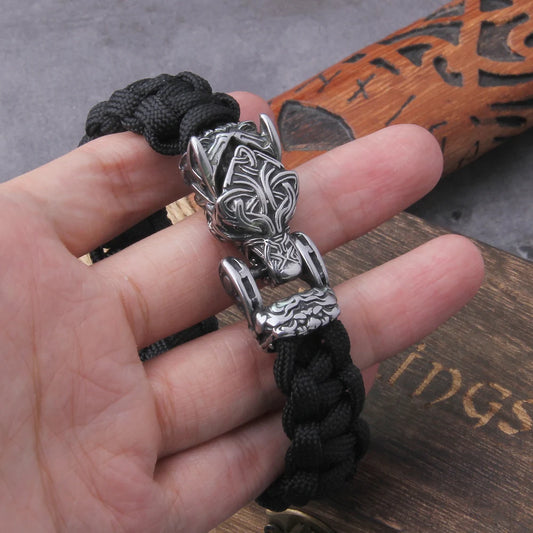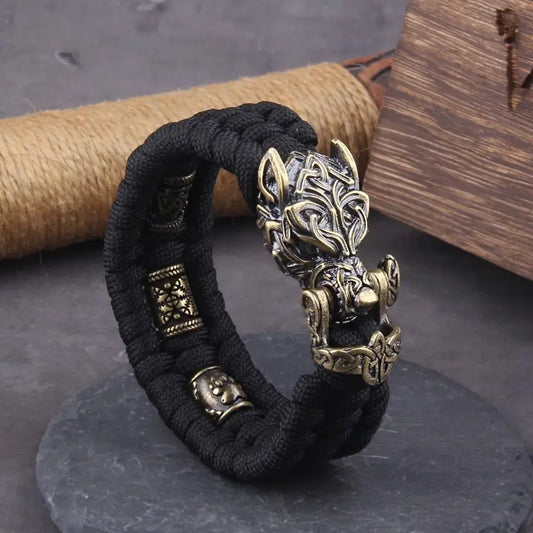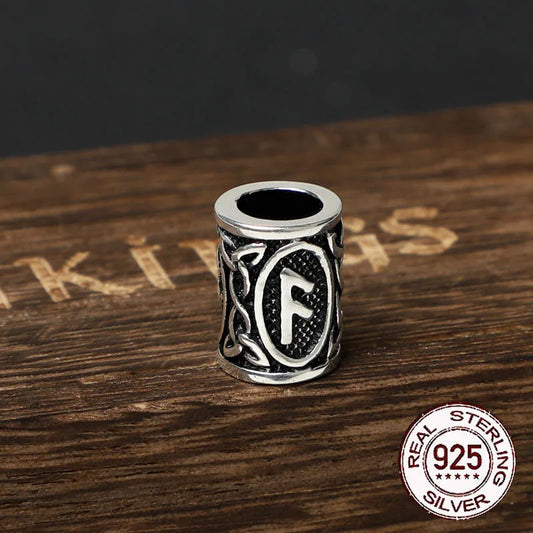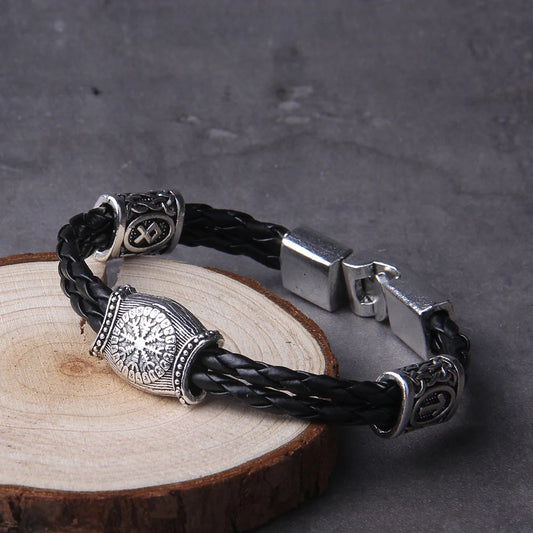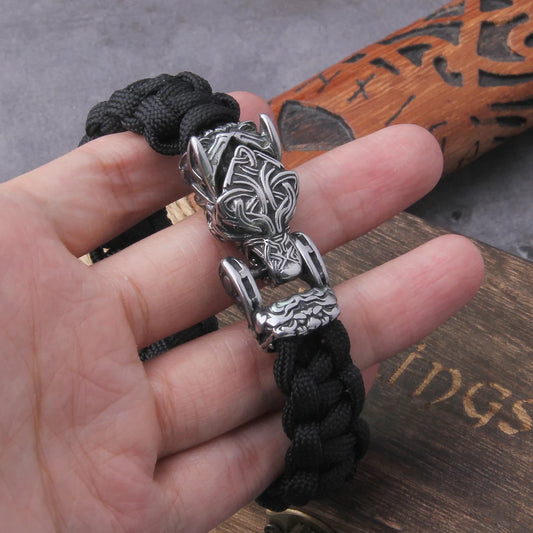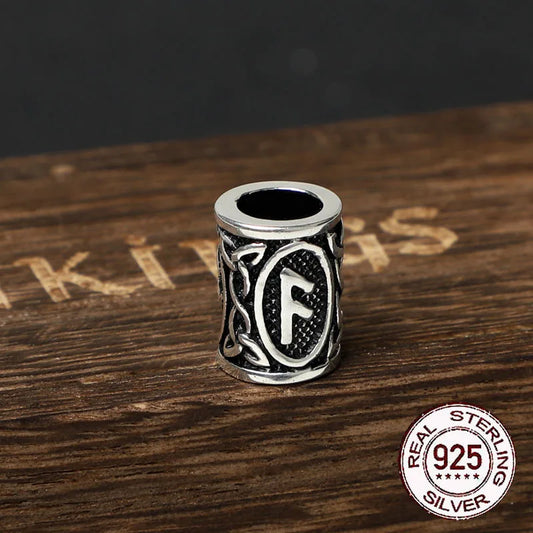The Varangian Guard is the name by which Scandinavian and Germanic mercenaries (Vikings) who served in the Byzantine army from the 10th to the 14th century are known.
The phrase is first used in John Scilica's chronicle, the Madrid Scilica, under the year 1034. Vikings arrived to Byzantium through the Kiev Russia.
In 988 emperor Basil II has received from prince of Russia Vladimir Svjatoslavich a group in 6000 people for struggle against usurper Bardas Phokas and has organized from them tagma.
During the next two centuries the Vikings took part in the wars waged by the empire and served as court guards. The place of their accommodation was first the Great Palace, and from the time of the Comnenuses the palace complex of Mangana and the palace of Blachernae.
The Varangian guards were a select formation, renowned for their master's loyalty, physical characteristics, armament, clothing and discipline. Their officers were given court ranks - for example, Harald the Fierce had the rank of spatharocandidate. The head of the guard with the title akoluf was usually a Greek.
Etymology of Varangian
In the Greek language it first appeared to mean "Norwegian," and after the formation of a military unit it was used to refer to mercenaries of Norwegian origin. In Greek it first appears in the sense of "Norwegian", and after the formation of a military unit of them this word began to denote mercenaries of Norwegian origin.
In the later period, when the Anglo-Saxons and other Germanic peoples appeared in the Varangian guard, the term "Varangians" was extended to them as well.
There is a widespread theory identifying Varangians with Scandinavian Vikings and Russ. On the basis of the Greek sources till XII century it is difficult to understand, whom chroniclers understand under Rhosi. Probably, for Greeks the distinction between all barbarians coming from the north was not essential.
Evaluating the present state of the discussion about terminology, the famous medievist E.A. Melnikova believes the Scandinavian origin of the word "Vikings" proper to be doubtless.
Its Old Norse equivalent, Dr. Scandinavian, vaeringi, is repeatedly met in sagas, skaldic poems, and chronicles, mostly with the meaning "a person in the service of Byzantium".
However, the term "vaeringi" begins to be used later than the earliest evidence about the presence of Vikings in Byzantium - around the late 980s. The common name for those who visited Greece in the sagas is Grikklandsfari ("traveled to Greece"), while calling someone a "waring" often clarifies the nature of his military service. At the same time the authors of the sagas contrast the "waring" and the "Normans", distinguishing them as private and general concepts.
Greek word Greek Βάραγοι for the first time meets in the chronicle of historian George Kedrin at the description of events 1034. For Vikings of English origin since XIII century in official documents the term "Anglo-Vikings" (cf. Greek έγκλινοβάραγοι) was used.
Varangian Guard Mercenaries
By the ninth century the Byzantine army consisted of two main parts, different in the way they were formed. One part was formed on the basis of the militia formed in the femas, of which by the reign of Emperor Theophilus there were 11 in the Asian part of the empire and 12 in the European part.
The soldiers supplied by the femas were called stratiotes and akrites. After the military reforms of Emperor Constantine V (741-775), when the units of the palace guards stationed at Constantinople and performing exclusively ceremonial tasks were converted into combat units, there was a division of the regular army into four tagmas: Schol, Escuvites, Icanates[en] (formed during the joint reign of Constantine VI (780-797) and his mother Irene), and Arythms (formed under Nicephorus I (802-811)), headed by their domestics.
Besides these units, the Byzantine emperor had detachments of foreign mercenaries serving mainly in the personal imperial guard (cf. Greek ἑταιρεία, aetheria).
The gradual decline of the feme army and its inability to meet complex combat tasks led to the formation of mercenary units from foreigners, mainly from Western Europe.
The tagmas formed on this principle, each of which included soldiers of a certain nationality, served either in Constantinople or in the provinces.
The metropolitan Aetheria was divided into 3 (Great, Middle and Third Aetheria) or 4 parts. Presumably, the Great Aetheria consisted of Christian subjects of the empire, representatives of friendly nations were enrolled in the Middle Aetheria, and the others were enrolled in the Third Aetheria.
In the late ninth or early tenth century the Third Aetheria was abolished and most of the mercenaries served in the Great Aetheria since then.
In terms of pay, the units of the Byzantine army also differed. The feme army received most of its pay from granted land grants, while in the regular army soldiers received an annual salary (ruga), which varied according to position and unit.
However, in order to enter such service one had to pay an entrance fee corresponding on average to the ruga for three years. Under the same name are also known lump-sum payments made on extraordinary occasions.
In the major source X of century, treatise "About ceremonies" of emperor Constantine Porphyrogennetos (913-959) which data (along with other treatise of the same author, "About management of empire") often for the reason of absence of alternative extend and other periods of the Byzantium history, is informed, that before sea expedition to Crete in 902 to 700 Russian mercenaries 7200 nomism руга, that is approximately 11 nomism on the person was paid.
In Greater Aetheria the payment was about 40 nomism per month. It is unknown, whether it was required to pay an entrance fee for receipt in Varyagiani guards, probably at Basil II (976-1025) or one of his direct successors this necessity has been cancelled.
For Vikings serving outside of the capital, the payment was considerably less, 10-15 nomism a month. The pólútasvarf[es] or pólotasvarf, mentioned by Snorri Sturluson as the source of Harald the Harsh's great wealth, might have been an extraordinary way of paying the Vikings.
The meaning of this concept is not quite clear. According to different versions it could be either the right or the possibility to plunder the emperor's palace or the right to collect some tax.
Ethnic Composition of the Varangian Guard
For the first time the presence of Viking detachments in Byzantium is noted in the reign of Emperor Theophilus (829-842), when warriors from the north reached the shores of the Black Sea and threatened the city of Cherson, the capital of the eponymous feme.
After that the Bertinian annals report about the Vikings at the court of the Byzantine emperor, according to which a delegation from the Byzantine court arrived to the court of emperor Louis the Pious in Ingelheim on May 18, 839, including those "whose people called Ros" and whose king was called Kagan (lat. rex illorum Chacanus vocabulo).
Probably, that they were messengers of the Vikings prince with whom Theophilos negotiated a possibility of inviting a unit of mercenaries. According to A.A. Shakhmatov's assumption, their purpose was the establishment of friendly relations with Byzantium and a way to Sweden through the Western Europe.
Some years later, in reign of Michael III (842-867) "Tavro-Scythians" (cf. Greek Ταύρικες Σκύφαι) were on service of emperor and are mentioned by Genesis as murderers of court eunuch Theoktistos[en] in 855.
In 860 Russ has made a campaign to Constantinople from what Michael III could draw conclusions about military potential Vikings, however is not known, whether then Vikings on imperial service have appeared. Attributed to emperor Leo VI (886-912) Tactica Leontis reports nothing about them.
Next time Rhosi appear in the Byzantium sources in the mentioned above story of the treatise "About ceremonies" in connection with expedition to Crete in 902. Under 907 in " Stories of time years " it is told about a campaign of Prophetic Oleg and two contracts made after that.
The second of them made in 911, included the provision about possibility of employment Russ on the Byzantium military service: " If there will be a set in an army and these (Russichi) will want to honor your tsar, and how many would not come them in what time, and will want to remain at your tsar on the will, so let it will be ".
In connection with the story about travel of princess Olga to a court of emperor Constantine VII in 955 or 957 the author of " Stories of time years " mentions the request earlier expressed by emperor about sending of soldiers-vikings (Russ), and in " About ceremonies " baptized dews in structure of palace guards are mentioned.
The Vikings were not the only ethnic component of the Byzantine army. Speaking of its national composition, Arab sources mention Russians, Khazars, Ferghans, Alans, Oghuzes, Pechenegs, Georgians, Armenians and Franks (cf. Greek Φράγγοι).
The Armenian historian of XII century Matvei Edessa mentions also "inhabitants of distant islands", but most likely he had in mind the Scandinavians.
According to the official document of the period of reign of emperor Michael VII (1071-1078) the army includes Russian, Varyag, Kolbyag, Frank, Bulgarian and Saracen groups. A similar list is contained in the chrysovulus of 1079 of Emperor Nicephorus Votaniatus (1078-1081).
At Alexei I Komnenos (1081-1118) in 1088 the list following: Russians, Vikings, Kolbyagi, Englishmen (cf. Greek Ίγγλινοι), Franks, Germans (cf. Greek νεμίτζων), Bulgarian, Saracens, Alanian, Abazian, "immortal" and other Romani and foreigners.
The nature of these documents and specificity of the Byzantine legal language do not exclude that designations of peoples used in these lists are not mutually exclusive. Of the named peoples the Englishmen are traditionally ranked as Vikings.
The first on emigration Anglo-Saxons to Byzantium after conquest of England by Normans in 1066 has paid attention French Byzantine the 17th century Duquesne who has considered the basic sources on this subject - chronicle of Orderik Vitale (the middle of XII century), the story of Anna Komnena and others.
According to Ducange, most of the emigrants from England to Byzantium were Danes, and they began to arrive in Byzantium after the death of Knud the Great in 1035.
The Danish theory is now considered to have no confirmation, and the basic observations of Ducange were rediscovered in 1871 by the English historian E. Freeman.
According to this researcher, migration began already after fight at Hastings, but the mass character has got only in board of emperor Alexey I Komnin (1081-1118).
In 1874-1875 this question was investigated in more detail by V.G.Vasilievsky who has paid attention that on Byzantium service " variagogo English team " has received an opportunity to be at war against normans with which empire conducted in the beginning of reign of Alexey I war on Balkans.
Precise time framework of occurrence English mercenaries in Byzantium is not quite clear, as according to Orderik Englishmen have sailed to Byzantium and have been accepted Alexei I already in 1060th that is an obvious anachronism.
Four mentions "Vikings from Fula" (cf. Greek οί έκ τής Θούλης Βάραγγοι) in Anna Comnenus' chronicle are considered possibly concerning to Englishmen.
However, she, reporting the events of the early 1080s, speaks of them as having already long served the empire. From it V.G. Vasiljevsky concludes, that she is confused in an ethnic accessory of barbarians, and speech at her goes about Scandinavians.
However, according to A.A. Vasilev, this seeming contradiction can be explained by the fact, that Anna Comnena wrote her memoirs after 1148, when the prevalence of Englishmen among Vikings became already long ago an accomplished fact.
The opinion that Anglo-Vikings played a significant role since the end of XI century is disputed by the German Byzantine scholar F. Dölger J. Shepherd. Further argumentation in favour of a significant influx of Anglo-Vikings already in the late 1070s leads.
Structure of the Varangian Guard
The chief of the Varangian guard was called acoluf (cf. Greek ἀκόλουθος) or acolytus (Latin acolythus).
The definition of this position is given in the mid-14th century treatise "De Officiis" by Pseudo-Kodin: "the acoluf is in charge of the Varangians: at their head he accompanies the emperor; therefore he is called acoluf, that is accompanying".
This title is mentioned as early as in Constantine Porphyrogenitus' treatise "On Ceremonies", and at that time it was the chief of the detachment of foreign mercenaries.
It was quite an important position. Although the akoluf was subordinated to the vigla's druingarius, he was largely independent of him.
Under the Paleologians the akoluf held the 51st position in the court hierarchy. The akoluf's attire due to his rank is also described by Codin: a turban with golden embroidery, a silk kabbadion and a scaranik with a small red tassel.
The duties of the akoluf included in some cases performing important military tasks in the role of commander, as well as participating in court ceremonies and even diplomatic missions.
The acoluf had several primikiri as assistants. The primikiri were subordinated to the territorial units of the Vikings and, as far as is known, this position could be held by Greeks. The position of "great interpreter of the Vikings" (cf. Greek μέγας διερμηνεύτος) is also known by name.
In contrast to the emperor's guards from among the Greeks who made up the tagma of the exquisitors, not all Varangians were stationed at the court. Of the whole Varangian corps only a small portion was selected, who were kept in the palace and carried a personal guard, serving as bodyguards, honor guard.
These were selected or palace Varangians (cf. Greek οί έν τώ παλατίω Βάραγγοι), carrying axes on the right shoulder, who stood by the imperial throne and followed the emperor during exits. Besides them there were also "outer Vikings" (cf. Greek οί έκτός Βάραγγοι), who carried combat duty and lived in the femes.
Notable Varangian Guard Battles
Until the death of Roman III in 1034
In 949 ships Russ (ousii, Latin ousiai, cf. Greek ούσία) participated in protection of sea coast at Dyrrachium and in Dalmatia. In the same year 629 Russ (avg. Greek Ρώς) were sent as a part of expedition to Crete.
According to the Arabian sources, in the Byzantium army which has suffered on October 30, 954 defeat near Hadas[en] from Seif-ad-Daula[en]* were representatives of people Russ.
Under assumption of the French historian A.Rambaud, they participated also in the previous campaign to Syria in 947. Though confirmations it is not present, some historians believe, that Russ participated in campaigns Nikephoros Phokas (963-969) on Cyprus, Syria and Sicily at the end of 950 - beginning of 960th.
Frequent mention Russ in works of the Byzantium historians has given the basis to the French biographer of this emperor L.-G. Schlumberger to believe, that already then existed the separate Vikings division of guards, however it improbably.
In 967 on behalf of Nikephoros prince Svyatoslav Igorevich has carried out a gain Bulgaria. About one more military episode in this reign it is known from words Liutprand Kremonsky, informed about sending to Italy fleet from heulandites among which there were two Russian and two Gallic.
Probably, were meant ships Vikings and Normans. Schlumberger's assumption that murder Nikephoros in December 969 has been made with participation Vikings also is not confirmed by anything.
During board John Tzimiskes (969-976) it is not known mentions Vikings on the Byzantium service, if not to count the continuation of the Bulgarian campaign of Svyatoslav Russian-Byzantium war in 970-972.
Under 980 in Stories of time years the story is resulted, how prince Vladimir Svyatoslavich has sent from Kiev to Byzantium demanding from townspeople a ransom Vikings.
As soon emperor Basil II (976-1025) the case of Vikings' guard was formed, D.S. Likhachev accepts dating, specified in annals and connects these two events, however in A.A. Shakhmatova opinion transfer of events of the beginning of Grand Duke Yaroslav Wise when in 1017 Vikings rampaged in Kiev took place.
The most important milestone in the history of Varangian guards is considered an arrival to Basil II of a detachment of 6000 "Tavro-Scythians" to help in suppressing the rebellion of Bardas Phokas in 987-989.
According to historian of second half XI century to Michael Psell, " tsar Basil has reproached ungrateful Rome's, and as shortly before it the group of perfect Tavro-Scythian soldiers, has detained them at itself, has added to them other strangers and has sent against enemy army ".
Academician V.G.Vasilevsky in the work of 1874-1875 " Varyago-Russian and Varyago-English team in Constantinople in XI and XII centuries " interprets these enough uncertain expressions Psell as the instruction that here goes about those Vikings which have been sent from Kiev in 980, and in 989 they have been organized in separate group.
The story independent of Psellas about these events contains in chronicles of historians of XII century George Kedrin and John Zonara, establishing a causal relationship between occurrence Vikings group, marriage of prince Vladimir with sister Basil II Anna and the subsequent christening of Russia in 988.
Armenian historian Stepanos Taronetsi under 1000 informs about meeting between emperor Basil II and king of Abkhazia Bagrat when one of accompanying emperor "ruz" has entered into dispute because of hay with Iberian. As a result "Ruz" was killed, "then all the people of Ruz, who were there, rose to fight: they were 6,000 men on foot, armed with lances and shields, which King Basil asked King Ruz at the time when he gave his sister in marriage to the latter. - At the same time Ruzes believed in Christ.
All princes and vassals Taik's have acted against them and have been defeated ". V.G. Vasilevsky connects this clash Vikings (Russ) with Georgians with that Varda Foka, as it is known from Psell and Taroneci, leaned, except Greeks, basically on Georgians.
Thus, in 989 Bardas Phokas's Georgians have suffered defeat from the Viking detachment. Simultaneously with a problem of chronology of the specified events, there is a debatable question on national structure sent Vladimir's detachment.
Supporters and opponents of the Norman theory consider soldiers from it either Scandinavians, or Slavs. Terminological confusion is aggravated by the Italian authors making distinction between Vikings on imperial service and Russ, telling about sent by Basil II to the aid catepan of Italy.
During the reign of Basil II there are no direct references to participation of Vikings' guards in military actions, but, in the opinion of the Icelandic researcher S.Blondal there is no doubt that exactly thanks to them emperor was able to keep the peace inside the empire and successfully resist to external threats.
In J.Kulakovsky's opinion data of the anonymous military treatise De re militaris, attributed to commander Basil II Nikephoros Uranus, can be understood as the instruction that in campaigns against Bulgarian this emperor the division of Russ took part.
Unconditional, in opinion Blondal, is participation Vikings in Syrian campaign Basil II in 999 when according to Arabian chronicler Jahja Antioch Russ has set on fire church in Emesse together with inhabitants which have hidden there. Year later there was an incident with Georgians described above.
In 1016 in Bulgaria at section rich extraction Russ the third part of her has been allocated. In 1019 at Cannes[en] Normans have been broken by Russian mercenaries.
In chronicle George Kedrin the episode is resulted, happened shortly before Basil II death when to a court has appeared certain Chrisohir, the relative died by then prince Vladimir Svyatoslavich, together with group in 800 people and has expressed desire to act on hired service.
In reply to the emperor's demand to disarm in advance, Chrysokhir refused and left via the Propontid. There he landed at Abydos, easily defeating the local stratigue, but the detachment was eventually dispersed.
Direct successors Basil II, his brother Constantine VIII (1025-1028) and son-in-law Roman III (1028-1034) did not possess military talents and at them about Vikings the guard up to arrival to Byzantium of Harald Severe it is not known.
Perhaps it was the Vikings that Kedrin had in mind in his account of how only through the bravery of the guards did the emperor manage to escape his defeat at Aazaz. In 1032 Vikings, probably, were in George Maniac's army at capture Edessa.
Harald the Fierce in Byzantium, 1034-1043
According to modern accounts, the surviving editions of the saga of Harald the Harsh's stay in Byzantium go back to the accounts[no] of Halldor Snorrason,[es] who served with Harald for a time.
In The Circle of the Earth, written by Snorri Sturluson, a descendant of Halldor, around 1230, a separate saga is devoted to Harald. The sequence of events in Harald's life after his defeat at Stiklestadir in 1030 is fairly well known.
After the battle, in which he participated at the age of fifteen, he went into hiding for some time, received medical treatment, then moved to Sweden, and in the spring of the following year went "eastward to the konung Jaritzleiv".
There, according to Snorri Sturluson, he became "a heuvdin over the konung's men guarding the country," which according to S. Blöndal is an obvious exaggeration.
The account from Rotten Skin that Harald "sailed in warships to Miklagard with a large army" is usually dated to 1034 or 1035. Under what emperor it happened the Byzantine and Scandinavian sources disagree - according to Snorri Sturluson it was during the reign of "Zoe the Mighty" and "Mikjal Katalact", that is Empress Zoe and her coemperor Michael Calafat (1041-1042), but a contemporary and eyewitness of these events states that "Aralt" (cf. Greek Άράλτης) wished to kneel and learn the Byzantine orders before Basil Michael Paphlagonian (1034-1041), the second husband of Zoe.
The size of Harald's "great army" is indicated only by Kekavmen and, in his opinion, it was made up of "five hundred brave soldiers". The position Harald occupied at the Byzantine court is not quite clear.
According to Kekavmen, soon after his arrival Harald set out with an army for Sicily. Relying on the data of the Scandinavian sagas a number of historians, for example A. Stender-Petersen came to the conclusion that the young prince was put at the head of the whole Viking army. G.G. Litavrin considers it unlikely.
According to V.G. Vasilievskij's opinion, "Harald and his Scandinavian comrades ... formed a special detachment in a foreign Greek corps". At the same time the Kekavmen's story is placed in the chapter that the emperor should not trust foreign mercenaries with high posts, and the case of Harald, who after his success in Sicily received the low rank of manglavite and was awarded the rank of spatharokandit at the end of his service is also not very significant.
According to S. Blöndal's suggestion, based on the poems of Bolverk Arnorsson from the collection Rotten Skin, Harald's detachment was involved in fighting piracy, which intensified after the death of Basil II during the first phase of his service.
This may have been as part of the auxiliary fleet sent by Michael IV to the shores of Sicily. The poems by Snorri Struloson and Harald's own poems report that Harald went on a military expedition to "Africa", but in this context the word Dr. Serkir should be understood as referring to the Arabs or Arabic-speaking peoples.
To 1034 concerns George Kedrin's story about stay Vikings on winter apartments in feme Thrace, remarkable that in it the rigor of discipline established at the Scandinavian mercenaries is specified. According to Kedrin, a Viking tried to rape a local woman, but was killed by her with his own sword.
Vikings found out about it have given the woman all property dead, and his body has thrown out without burial as it was accepted for the suicides. Approximately during this time Byzantium waged war with Pechenegian and one of the statements of the German chronicler of second half XI century Adam Bremen historians consider as the instruction on possible participation in these events Harald.
Also probably participation Vikings in the wars which went in Asia Minor - capture of Edessa by George Maniac and removal of its siege by Constantine Katallak in 1036 and suppression of revolt of Adam Sevastia, son of last king Vaspurakan Senekerim Arzruni in 1034.
Perhaps the saga's account of Harald's conquests in "Jorsalaland", i.e. "the land of Jerusalem", indicate that his retinue guarded the Christian pilgrims to that city, which became possible at the beginning of the Caliph al-Mustansir's rule (1036-1094).
The most known campaign of Harald's detachment is the expedition to Sicily under the command of George Maniac (Gyggir, from the Sagas) in 1038-1041 against the Normans, information about which has survived in numerous sources, including in an artistic translation of the Sagas.
In this campaign Vikings took part in sea and overland battles. In several battles the victory was achieved thanks to the Scandinavians' bravery and with minimal losses on their part, in others - at Olivento and at Montemajor[en] their losses were substantial.
Much attention in the sagas is given to the personal conflict between Maniak and Harald, caused not least by the harsh character of the Byzantine commander. Harald's last military accomplishment in Byzantine service was to take part in the suppression of the revolt against Byzantine rule by Peter Deljan in Bulgaria, for which the Vikings were recalled from Sicily in 1040.
The events preceding Harald's departure from Byzantium are not quite clear. Probably, it and its group have taken part in overthrow and blinding of emperor Michael Calafate (1041-1042) that can be explained including that the new emperor has released from prison Maniac where he has been imprisoned in connection with the conflict with a member of a ruling dynasty.
The story of Harald's acquiring his incredible wealth, his imprisonment and subsequent flight is probably unrelated to the story of the Viking corps. According to S. Blundahl, the final defeat of the Bulgarian revolt near Ostrovo[en] took place without Harald, though the Vikings took part in it.
Till the beginning of board of Alexius I Komnin, 1043-1081
During board of the third husband of Empress Zoe Constantine IX Monomakh (1042-1055) weakening of military power of the Byzantium empire proceeded. During a campaign of Yaroslav Wise to Constantinople Vikings groups have been on any case sent from capital in remote provinces.
In the Georgian chronicle participation in 1045 of 3000 Byzantium Vikings in internecine conflict of Georgia between the ally Byzantium prince Liparits and tsar Bagrat IV is fixed. M. I. Brosset's translation of the chronicle, according to which the Vikings came to Bagrat's aid, is considered erroneous in this place. In the same year with the help of 700 or 800 Vikings Liparit finally defeated Bagrat in the Sasiret valley.
In 1050 the Byzantium army under command of great etheriarch Constantine Arianit suffered defeat from Pechenegian near Adrianople, however fall of capital Macedonia has been prevented by the scholarians under command of Nikitas Glava timely arrived to the help.
A new army under the general command of the ethnarch Nicephorus Vriennius[en], including Normans and Vikings hired in Southern Italy and led by Acolufus Machaelus, was formed for further war against the Pechegs.
After several victories and defeats, the war with these nomads was ended by a 30-year peace.
In the 1050s, between and after the campaigns against the Pechenegs, the Vikings fought quite successfully in Asia Minor against the Seljuks of Togrul-bek. The few Byzantine successes in Italy in 1046 and 1048 are associated with the Vikings.
After death of Constantine IX in January 1055 Vikings are mentioned in connection with palace events - unsuccessful plot Theodosius and struggle between Michael VI Stratiotik (1056-1057) and Isaac Komnenos (1057-1059), and in the latter case Vikings battled on the party of both applicants for authority.
In embassy Stratiotik to Isaac Komnenos the historian Michael Psell participated, due to whom the description of appearance of Vikings from personal guard Komnenos which it prefers to name "Tavro-Scythians" was kept.
In short reign Isaac I Vikings are mentioned only once, when in 1058, emperor has sent group of mercenaries to arrest patriarch Michael Cerularius. As John Zonara informs, soldiers with dishonor have dragged the patriarch from a throne and, having planted on mule, have sent to port.
Probably, it was impossible to entrust such commission to the Greek soldiers. However it is quite possible, that without participation Vikings did not manage in campaigns against Pechenegian and Hungarians in summer 1059.
Under Constantine X Duke (1059-1067) Vikings took an active part in the battles of Italy - in 1066 they were sent to defend Bari, and defeated Robert Guiscard in the sea battle of Brindisi at the same time. Nevertheless, in April 1071 the last Italian possessions of the empire were lost. In memory of the Vikings a part of the harbor of Bari is called Italian. Mare dei Guaranghi.
After the death of Constantine X in 1067 the throne was given to Roman IV Diogenes (1068-1071) as the new consort of the late emperor's widow, Eudocia. The new emperor, popular among the Greek part of the army, caused discontent among the Varangians, who resented the removal of the sons of Constantine X from power.
Nevertheless, the Vikings are mentioned among the troops sent to Asia Minor against the Seljuks in 1068. In disastrous defeat at Mantsikert in 1071 together with emperor all his protection was lost, after that the group of "provincial Vikings" has stopped the existence..
In board of a son of Constantine X Michael VII (1071-1078) Vikings are mentioned in connection with suppression of mutiny Nikephoros Vriennius the Elder. Telling about these events, the historian Michael Attaliat obviously names the Vikings who were fighting in this case both at sea and on land, "Russians", which, in V.G.Vasilievsky's opinion, unequivocally points at the synonymity of these notions.
Michael VII decides not to resist the next rebellion, undertaken by Nicephorus Votaniates (1078-1081), having refused to follow the advice of his commander Alexius Comnenus and to send Vikings to quell the disturbances.
In turn, Vriennius continued to fight against Votaniatus. In the decisive battle of Kalovaria Comnenus defeated the usurper's army of 5,000 Normans and a considerable number of mercenaries who had joined the rebellion for non-payment of wages under Michael VII.
Nicephorus Vriennius was blinded as a result, and his brother John was murdered in Constantinople shortly afterwards. As Kedrin reports, he was hacked to death with an axe by a Viking, whom he had earlier ordered to have his nose cut off.
The emperor probably had no choice but to execute the murderer after this, but the story displeased the other Vikings. Some of them attacked the palace, but this time Nicephorus managed to fight back with the help of the Greeks who remained loyal.
The incident was investigated and only the direct perpetrators were punished. When in March 1081 Alexei Comnenus began his rebellion, the Vikings and Cumans remained loyal to Votaniates. Nevertheless, the emperor, learning of the revolt in the fleet, preferred not to resist and yielded power without bloodshed.
Before the fall of Constantinople in 1204
With the accession to the throne of Alexius I Comnenus (1081-1118) the wars with the Normans resumed. The formal occasion was the desire of Robert of Guiscard to avenge Michael VII, whose son was married to Guiscard's daughter.
The main battle of the 1081-1085 war at Dyrrhah, fought on October 18, 1081, was fought by Vikings led by Nambiti. The details of that battle were described by the daughter of the emperor, Anna Comnena.
According to E. A. Seren, the formation of the Vikings in this battle was a classic skjaldborg. In the course of the battle, which ended in defeat for the Byzantines, Nambit's warriors broke away from the main body of the army and were ambushed. Having tried to hide in church, they were burned in it..
After defeat Alexei has left 500 Vikings in the castle Kastoria which Normans could take only after long siege. Though the Vikings are not mentioned by Anna Comnena during the chronicle of the main battle of Pechenegs war in the end of 1080th, according to S.Blundahl there is no reason to doubt that they were there. The same is true for the wars against Serbs and Turks, led by Alexey Komnin. Participation Vikings in actions in Asia Minor together with crusaders after 1097 also is assumed.
The events of the First Crusade led to an increase in the number of Vikings in Byzantine service. To the traditional channels of attracting this category of mercenaries (individual recruitment, recruitment by international agreement, through an emissary) was added the involvement of pilgrim crusaders.
Most often for this reason came to Byzantium warriors from Norway and Denmark, who combined military service with pilgrimage to the holy places. In the account of Saxo Grammaticus in details is known about stay at a court of Alexius I of the king of Denmark Erik I who has arrived with the spouse and the big retinue to the Byzantium capital with pilgrim purposes.
According to Blöndal, some people from Eric's retinue were hired by Alexios and Eric was "gifted" half a gold lest (D. Skand. gulli rauðu halfa lest) - value equivalent to 40 talents.
These Vikings were sent to serve in the garrison of Paphos fortress in Cyprus. According to an estimation of the same researcher, as a result of the visit of two Scandinavian monarchs on Byzantium service has arrived from 4 up to 5 thousand soldiers.
In the reign of Alexius I the English begin to prevail among the Vikings. Besides participation in actions with Normans in the beginning of 1080th, sources note their service on protection of an imperial palace.
In J.Shepard's opinion the fleet of English mercenaries played an important role in defeat Pechenegian in 1091. The Yathward saga[en] (which reliability is disputed) names "Sigurd, Earl of Gloucester" as commander of this fleet, who is hypothetically identified with the well-known in the Doomsday Book Sivard Barn.
After the death of Alexius I in 1118 the Vikings played an important role in transferring power to the late emperor's son, John II (1118-1143), whose right to power was contested by his mother and older sister.
During his long reign John II fought numerous, mostly successful wars. The only episode in which the participation of Vikings is reliably known is the 1122 Battle of Beroe as a result of which the Pechenegs were finally defeated and ceased to pose a threat to the empire.
In the other battles of this reign the Vikings are not mentioned. Scarce evidence from the sources allows us to establish that at this time the Vikings were equipped with long shields and axes.
After John II died under suspicious circumstances, his son Manuel I Comnenus (1143-1180) became emperor. Patriarch Michael II's panegyric mentions the support given to the new emperor by the people "carrying single-sided axes and coming from their houses in the North Pole."
In the reign of Manuel I the Vikings are mentioned in connection with the dramatic siege of Kerkyra described by Nikita Honiatus, which took place during the campaign against the Sicilians in 1147-1149.
During the same years the army of the Second Crusade reached Constantinople, which included the Norwegians. The saga about Orkneys, narrating about visiting the Byzantium capital of Earl Rögnvalda, gives the information on the members of Vikings' guard, in particular about Eindridi Yun who occupied in it one of supervising posts.
According to S. Bløndal estimates the inflow of Norwegians into the guard together with pilgrims was from 800 to 1000 people. Vikings are mentioned in different wars of Manuel I in 1170th including the defeat for Byzantium at Miriocephale.
After death of Manuel I emperor became his juvenile son Alexei II (1180-1183), his mother Maria Antiochian and cousin Protosevast Alexei Komnin have been appointed as regents at him.
Having secured the support of the Varangians, the emperor's relative Andronicus Comnenus first became co-emperor and then sole ruler. Up to falling of Constantinople about Vikings in sources meet only scattered mentions.
During storm of city Vikings protected Galata Tower in July 1203, participated in a sequence of coups in 1204. After final fall of city in April 1204 they have surrendered on mercy of winners then Vikings the guard has stopped the existence.
Before the fall of Byzantium in 1453
There are no explicit indications of the existence of Varangian guards at the court of the Latin emperors, but some data from the sources can be understood as indicating the presence of Icelanders in the capital, but it is not known whether they were in any way united among themselves.
However, the emperors of the Nicaea Empire, who sought to reproduce the traditional Byzantine ceremonial, organized their guards on the model of the former.
Under emperors Theodore I (1204-1221) and John III it consisted of five regiments, one of which, the Celtic Pelekophorians (cf. Greek πελεκυφόρος, "sekironosets"[note 8]), consisted of Vikings. In this period Varangians were understood to be mainly English or Scots.
In the first half of the XIII century there were no direct mentions of Vikings' participation in military campaigns, but there were rather many of them after the accession of Michael VIII (1259-1282) during whose reign Byzantium experienced its last heyday.
After Michael VIII's death the Vikings are mentioned only in a ceremonial context. In connection with the fall of Constantinople in 1453 nothing is reported about the Vikings.
Participation in court and social life
By the reign of Alexius I Comnenus (1081-1118) only the exquisitors and the "immortal" remained of the traditional imperial bodyguard units, to which in the first half of this reign were added vestiarii[en] and Varangians.
After Alexei's death only Vikings and a new division of Vardariotes are mentioned in the sources. German Byzantine scholar A.Holweg, who has analyzed the reasons of such frequent changes in the structure of the palace guard, offered three possible explanations: the absence of loyalty of some divisions to a new governor, complexity of acquisition of ethnic groups and desire of the emperor to form an absolutely new division.
After 1204 these reasons might have been added to the financial one, given the shrinking resources of the empire. Although more is known about the palace guards than about the units that were stationed in Constantinople, no data about their numbers are known about any of them.
That the guards were not very numerous can be judged from the known case in May 1328, when Emperor Andronicus II (1282-1328) spent the night in the Blachernae palace without guards at all.
Pseudo-Kodin informs about five detachments of the palace guard, of which Varangians are most often mentioned. According to this author, during the festive dinners the Vikings wished the emperor long years after the Venetians in their own language - English - and banged noisily on the floor with their axes.
Having lost their military role in the later period of Byzantine history, the Vikings acquired many new responsibilities. They stood at the door of the emperor's bedroom and in his reception room.
Around 1360 in one of his letters the writer Demetrius Kidonis accused contemporary Vikings of extorting bribes from those wishing to enter the palace.
Among other duties Vikings are mentioned obligation to keep keys from the city where the emperor stayed, in Nicaea period possibly guarding the treasury, in the end of XIII century tortures by order of the emperor.. Vikings also accompanied the emperor during his divine exits to churches in the capital.
Reflection in the Sagas
The sagas contain many mentions of Scandinavian visits to Byzantium. The first Scandinavian to serve in Byzantium, the Icelandic tradition calls the Icelander Bolli Bollason. His stay in Byzantium conditionally date approximately 1030, that is late enough, and modern researchers specify a number of Icelanders, visited Constantinople before Bolli.
The "Saga of Tidrek of Bern" about konung Hertnite (Dr.-Scandinavian Hertnið), who "ruled over Rus and the most part of Greece and Hungary", composed in Norway about 1250, has a legendary character.
The "Saga of Hrafnkel", whose attribution to the oral tradition is questionable, mentions the merchant-sailor (Erskand farmaðr) Eyvindr Bjarnason, who at the time of king Harald Fine-hair went to Miklagard and "lived there for some time and won the favour of the Greek king".
The same saga speaks of a trip to Constantinople by Torkel the Lightbringer (Dr.-Scandan Þorkell Þjóstarsson), who "spent seven years in Miklagard and became an associate of the king of Miklagard".
The Icelandic historian Gvydbrandur Vigvusson[en] speculates that their travels date back to about 945. Finnbogi Åsbjørnsson[edit] Finnbogi Åsbjørnsson was a vigilante of Emperor John I Tzimiskes (969-976) according to the "Saga of Finnbogi the Strong". "Great honors," according to the "Saga of Hallfred," were won in Byzantium by Grís Samingsson (dr. Grís Sæmingsson), whose stay at the Byzantine court is dated 970-980 (Vigvusson, 1855), the beginning of the 11th century, 985-993 (F.A. Brown, 1908), 950-975 (E.A. Rydzievskaya, 1978).
The 1020s date the story of "The Saga of Njala" about the Icelander Kolskeggur Hamundsson[es] (Icelandic Kolskeggur Hámundsson) "went to Miklagard and joined a Viking retinue there ... married there, was the leader of a Viking retinue and stayed there till his death".
When, as the Saga of Grettir tells us, in the reign of Michael Calafat (1041-1042) or earlier, the adventures in Constantinople of Torbjörn Hook[es] (Þorbjörn öngull Þórðarson) and Torstein Dromund (Þorstein drómund Ásmundarson), there were already many people from the north in the Byzantine capital.
Harald Hardrad's stay in Byzantium is well known from the sagas - The Rotten Skin, The Beautiful Skin, The Saga of Harald the Harsh as part of Snorri Sturluson's Circle of the Earth, The Saga of the Orkneys and the synopsis of The Review of the Norwegian Konungs Sagas. Several of his cronies are named in connection with his saga adventures.
In 1937 A. A. Vasiliev argued that after 1066 the Scandinavians were displaced from the Varangian guard by Anglo-Saxons, and after 1081 this was even at the level of terminology, but since then a significant number of 12th- and 13th-century Nordic burials have been identified, indicating a less rapid and radical change in the national composition of the mercenary corps.
"The Saga of the Sons of Magnus the Naked" from the Circle of the Earth mentions the return from Miklagard after the death of Harald's grandson, konung Magnus in 1103 of Norwegians who were hired to serve the Greeks and "received a lot of money".
In the "Saga of Hakon broad-shouldered", there is a detailed description of how in 1122, thanks to the courage of a band of 450 Werings, 60 times bigger army of Pechenegs was defeated at Beroe.
According to the "Saga of Sverrir", "under Manuli konung", i.e. Emperor Manuel I Comnenus (1143-1180), the illegitimate son of King Sigurd II Eirik (Eiríkr Sigurðsson) served. The sagas contain mentions of Norwegians in Byzantine service until the end of the twelfth century, naming a total of 26 names.


